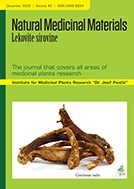Institute for Medicinal Plants Research „Dr. Josif Pančić“ , Belgrade , Serbia
Institute for Medicinal Plants Research „Dr. Josif Pančić“ , Belgrade , Serbia
Driven by frequent media misinformation about the level of profitability of growing certain medicinal plants, in this paper we presented a cost-benefit analysis based on twenty years of experience in field production. The observed costs and profits for peppermint, chamomile, lemon balm, marshmallow, valerian and pot marigold are based on the average values of production elements within the current prices of labor, energy and raw materials. Fixed costs in this paper were deliberately neglected and the discussion was based on the assumption of the existence and availability of infrastructure. In the cost analysis, we divided them into four main groups, which had different shares in total costs such as labor 45-79 %, drying 5 – 37 %, material, 9-16 % and machinery use 4-13 %. Regarding the level of profitability of cultivation of the six observed medicinal plants valerian was the most profitable with an estimated profit of over 4000 €/ha. Next best earning plants were lemon balm and marshmallow with about 3500 €/ha, while the income from peppermint and chamomile was more than twice lower and it was around 1500 €/ha. The lowest profit was realized by cultivating marigold (about 600 €/ha) due to the high labor consumption on the flower picking operation. In terms of labor consumption marshmallow, pot marigold and valerian are the most demanding with 365, 285 and 150 working days per hectare, respectively. The general conclusion of this observation of the profitability of growing medicinal plants would be that the producer must be aware of the costs and scope of labor engagement he expects per unit area before embarking on the calculation of production.
This is an open access article distributed under the Creative Commons Attribution License which permits unrestricted use, distribution, and reproduction in any medium, provided the original work is properly cited.

The statements, opinions and data contained in the journal are solely those of the individual authors and contributors and not of the publisher and the editor(s). We stay neutral with regard to jurisdictional claims in published maps and institutional affiliations.